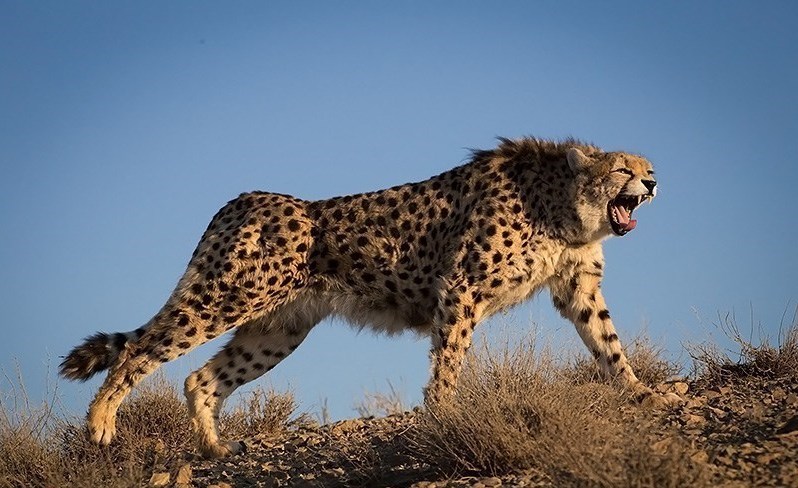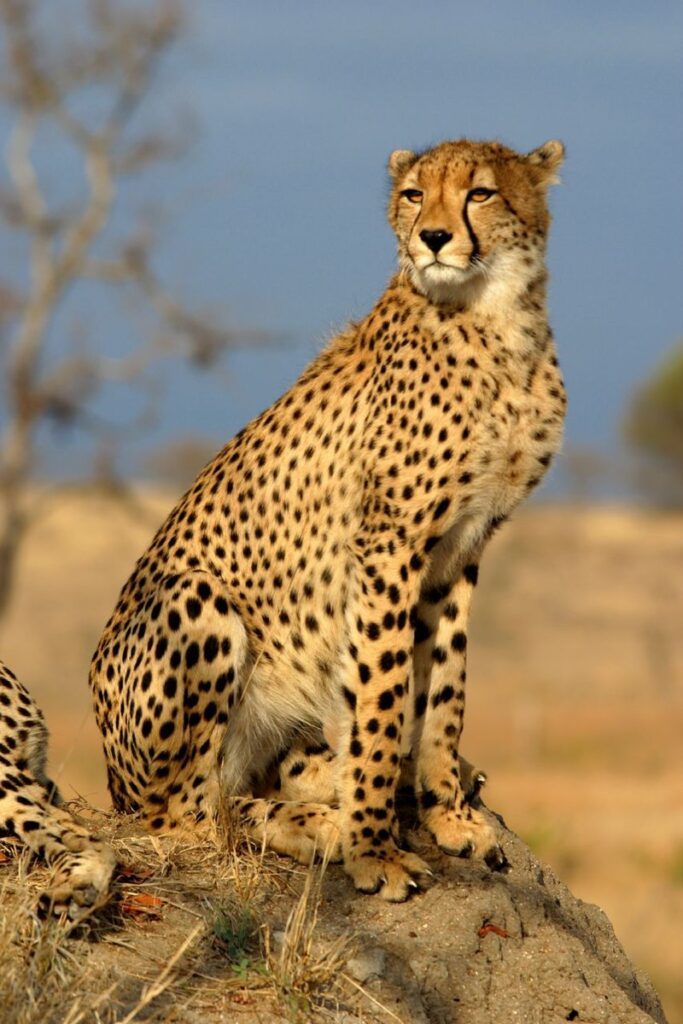On 17 September 2022, the cheetah, the fastest land mammal, was reintroduced to India at Kuno National Park in Madhya Pradesh. Cheetahs would once again roam India. The big cats formerly shared the landscape with tigers, leopards, lions and wolves. The cheetah is the only large native species which was driven to extinction in India. But what led to their extinction in India? Let’s patrol the whole story.

Historic Range of the Asiatic Cheetah
Asiatic Cheetahs once ranged over the grasslands of India, Afghanistan, Iran and the Middle East. In India, they were found as far south as Tamil Nadu. The Asiatic cheetah, also known as the “hunting leopard” in India was kept by kings and princes to hunt gazelle and blackbucks. Firuz Shah Tughluq is considered to be the first ruler in medieval times to use cheetahs for hunting purposes.
The first cheetah in the world to be bred in captivity was in India during the rule of the Mughal emperor Jahangir in the 16th century. His father, Akbar, recorded there were 10,000 cheetahs during his time, including 1,000 of them in his court. A BBC report states that between 1799 and 1968, there were at least 230 cheetahs in the wild in India.
In 1608, a white cheetah was known to be in possession of Raja Veer Singh Deo in Orchha. Mughal king Jahangir describes its spots to be of blue colour in his book Tuzuk-i Jahangiri. This is said to be the only recorded white cheetah.
What caused the extinction of the cheetah?
By the beginning of the 20th century, the species was already heading for extinction in many areas. There were certain places more affected by this problem than others. The Indian reserves were not very thoughtful when creating habitat loss for these oversized cats. The forests were cleared and extensively utilized for agriculture and human settlement.
They were intermixed with open grasslands grazed by large herds of blackbuck; these coexisted with their main natural predator the Asiatic cheetah. The blackbuck, no longer extant in Punjab, is severely endangered in India. Later, more habitat loss, prey depletion, and trophy hunting were to lead to the extinction of the Asiatic cheetah in other regions of India.
In 1947, Maharaja Ramanuj Pratap Singh Deo of Koriya, Surguja, in what is today known as Chhattisgarh, shot the last three recorded Asiatic cheetahs in India. With that, the Asiatic Cheetah was declared extinct in India in 1952. It is the only animal in recorded history to become extinct from India due to unnatural causes. Soon after extinction was confirmed. In 1955, the former State Wildlife Board of Andhra Pradesh suggested the reintroduction of the Asiatic cheetah in at least in two districts of the state, on an experimental basis.
Geopolitics halts the Cheetah Reintroduction efforts
In the 1970s, the Department of Environment formally wrote to the Iranian government to request Asiatic cheetahs for their reintroduction. The government apparently received a positive response. However, talks fell through because of the reasons of political instability there and the negotiations never progressed. In August 2009, Jairam Ramesh, the then-Minister of Environment, reportedly rekindled the talks with Iran for sharing a few of their animals.
Iran had always been hesitant to commit to the idea. This has been due to the very low numbers present in the country. It is said that Iran wanted an Asiatic lion in exchange for a cheetah, and that India was not willing to export any of its lions. The plan to source cheetahs from Iran was eventually dropped in 2010. Offers by the Kenyan government to send cheetahs to India were reported as far back as the 1980s. In 2009, the report by Wildlife Institute of India recommended sourcing cheetahs from Africa.
Is the African Cheetah ok?
Since the Asiatic cheetah was extirpated from India in 1952, plans to re-establish the cheetah in India have been ongoing. For this purpose, a meeting of cheetah experts was organised at Gajner in the Indian state of Rajasthan in September 2009.
The meeting also identified Namibia, South Africa, Botswana, Kenya, Tanzania, and the UAE as countries from where the cheetah could be imported to India. “About 5 to 10 animals annually have to be brought to India over a period of 5 to 10 years. The Ministry of Environment & Forests approved the recommendation for a detailed survey of potential reintroduction sites in the Indian states of Rajasthan, Gujarat, Madhya Pradesh, and Chhattisgarh, which were shortlisted during the consultative meeting.
Four more Indian states; Tamil Nadu, Karnataka, Andhra Pradesh, and Maharashtra were also considered. The survey would have formed the basis for the roadmap of reintroduction of cheetahs in India, and would have been carried out by the Wildlife Institute of India (WII). Wildlife experts have shortlisted three regions which have the potential to support cheetah populations. The Nauradehi Wildlife Sanctuary and Kuno-Palpur Wildlife Sanctuaries in Madhya Pradesh and the Shahgarh bulge landscape in Jaisalmer, Rajasthan have been declared potentially suitable for the reintroduction of the cheetah.

More about their new home!
The Kuno-Palpur Wildlife Sanctuary in Madhya Pradesh has the potential to hold populations of four of India’s big cats; the Bengal tiger, Indian leopard, Asiatic lion, and Asiatic cheetah, all four of which have co-existed in the same habitats historically for many years, before they were wiped out.
In August 2022, the Union Cabinet Minister of Forest and Climate Change, Bhupender Yadav stated that African cheetahs will be reintroduced to Kuno Wildlife Sanctuary in September. Yadav also stated that 8 cheetahs are being expected to come from Namibia. The Indian Government is also attempting to translocate another 12 cheetahs from South Africa to India.
What next for India’s Cheetahs?
On 17 September 2022, five female and three male Southeast African cheetahs between ages four and six, a gift of the government of Namibia, were released in a small quarantined enclosure within the Kuno National Park in the state of Madhya Pradesh. The cheetahs, all fitted with radio collars, will remain in the quarantined enclosure for a month, whereupon initially the males and later the females will be released into the 748.76 km^2 park. The relocation has been supervised by zoologist Laurie Marker of the Namibia-based Cheetah Conservation Fund.
Later in 2022, 12 cheetahs from South Africa will be released in Kuno, and eventually, the total number of African cheetahs in Kuno will be brought up to 40 individuals.
This Cheetahs were released by Prime Minister Narendra Modi as part of the programme to reintroduce the feline in India. Let us hope that the cheetahs can help restore India’s dying grasslands. We have already seen the imapct that the reintroduction of an apex predator can have on the ecosystem. The success of this project may encourage countries, such as the UK, to bring back predators, such as the Gray Wolf to tackle deer overpopulation. Nonetheless, it is crucial to do species disturbution modelling and habitat survelliance for such projects to be successful.
Conclusion
Help us Help Them! Think Wildlife Foundation is a non profit organization with various conservation initiatives. Our most prominent campaign is our Caring for Pari intiative. Pari is a rehabilitated elephant at the Wildlife SoS Hospital. 25% of the profits from our store are donated to the elephant hospital for Pari. Other than buying our wonderful merchandise, you could donate directly to our Caring For Pari fundraiser.
Written by Fatima Safeer
